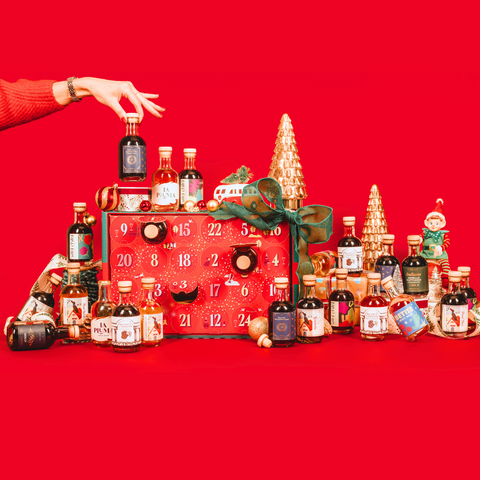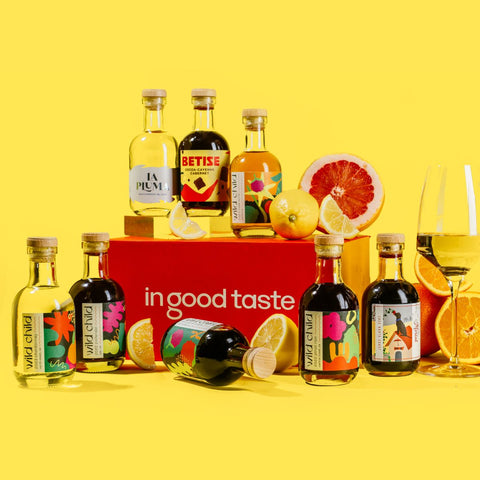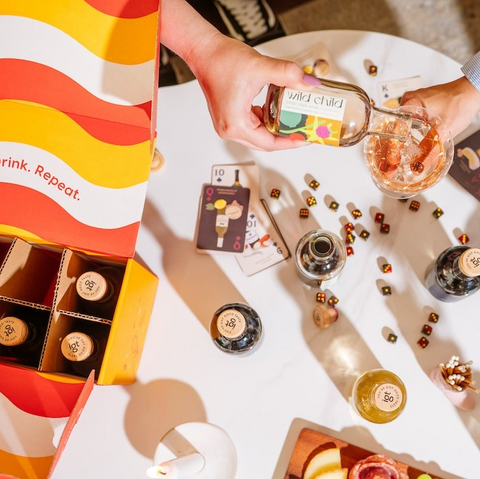The Basics of Rosé Wine
The anthem “rosé all day” has grown in popularity over the last few years, but if you’re new to drinking rosé, you might want to know how it stands out from other red or white wines. Is the anthem true for you, or just a catchy phrase?
With its signature pink color, rosé can be difficult to classify. Is it better suited in the red wine category, or does it belong to the white wine family? Is it a blend or its own distinct type of wine? Are rose petals involved? Does it taste sweet or dry? Does rosé only make an appearance poolside during the scorching hot summer, or is it a wine for all day and all year? This guide will help you determine if it’s the one for you—or at least a wine you’d like to try.
Related: Summer Sips - Best Wines for Summer
Rosé Wine Production
While rosé gets some of its pink color from grape skins, it’s not enough to be classified as a red wine. Some think rosé is made by mixing red and white wine, but this practice is strongly discouraged and even banned by law in some regions (who would’ve known!). Because of its unique and simple production process, rosé earns its own classification. Some even believe it’s the oldest known type of wine before its red and white contemporaries.
The most common rosé making process is the skin contact method in which black-skinned grapes are crushed, and the skins stay immersed in the juice for two to twenty hours. Then, after the grapes are pressed, the skins are thrown away rather than fermented with the juice as in red winemaking. The color of the final wine is determined by how long the skins remain in contact with the juice, which explains some of the different pink shades of rosé. Longer contact = darker shade.

Winemakers sometimes use the saignée (French for bleeding) method to make a rich, red wine with more tannin. By removing some of the pink juice in an early stage, the red wine becomes more concentrated, and the pink juice can be fermented separately. Fermenting the pink juice leads to rosé, essentially giving the winemaker a “two-for-one” winemaking process.
Remember when we learned mixing red and white wines was off-limits in some regions? Well, some places still allow it, and it’s the third way rosé can be produced. Not surprisingly, this technique is called the blending method. While this method of rosé production is literally outlawed in some regions of France, making Champagne this way is legal. It’s not typical, as most Champagne is still usually made with the saignée method, but it’s allowed!
What is “Body”?
You may have heard someone describe the “body” of wine and thought, “We get you like the wine, just say that. No need to use fancy terms.” But the term isn’t for show-offs and salespeople. It describes how a wine feels in your mouth, which is different than just how it tastes. A wine’s body is usually determined by the wine’s alcohol content, with full-bodied wine feeling thicker and heavier and light-bodied wines feeling … well, lighter. Rosé falls into the medium-bodied category most of the time, but let’s explore the full range of “bodies,” shall we?

Light-bodied wines are crisp and bright. Usually with an alcohol level under 12.5%, these wines offer a burst of flavor but don’t feel thick or heavy as you drink.
Medium-bodies wines usually have an alcohol content ranging between 12.5% and 13.5%, and they’re often described as smooth and refreshing—just like rosé.
Full-bodied wines inspire descriptions of rich and complex, and they feature the highest alcohol content, coming in at 13.5% or above.
Related: How to Sound Like a Wine Expert
What is Acid?
Acid might sound like the last thing you want to be associated with wine, but don’t worry, it’s a good thing. The level of acidity in wine goes back to the grapes used from the vineyard, but there are still several factors that influence acidity even before the grapes are harvested. For example, a grape cluster could have more acid because it’s unripe, hasn’t been on the vine as long, or comes from a colder region. A grape cluster that’s been ripe for a while, on the vine longer, or in a warmer climate will have less acid. But which is better—more or less acid? Depends on your tastebuds!

If you love a crisper rosé, the higher acid level allows it to pair perfectly with rich Mediterranean flavors like grilled salmon and goat cheese. But apart from taste, acidity helps good wine age well. Over time, the wine will taste less acidic even though the acidic level remains the same.
Types of Rosé Wine Grapes
Red grape varieties are used to make rosé, as the skin contact and saignée methods reduce the red color in the wine. So grenache, syrah, cabernet sauvignon, tempranillo, sangiovese, malbec, mourvedre, carignan, zinfandel, cinsault, and pinot noir are all common varieties used for rosé and even blends.
The flavors lean on the fruity side, so you can expect notes of strawberry, citrus, melon, raspberry, cherry, and fresh flowers. Even though rosé wines tend to the lighter side, they still offer a lovely range of sweet to savory to dry.
So what variety might you try the next time you’re in the mood for rosé all day?
Provence Rosé
Tasting notes: strawberry, rose petal
Hailed as the most versatile of rosés, the Provence rosé is a wonderful choice for any occasion. It’s some of the best rosé you can get, and it’s primarily produced in Provence, France—hence, the name. Its simple combination of strawberry and rose petal flavors makes it easy to enjoy on any occasion, from relaxed to formal, especially since it pairs well with a broad range of cuisines. If you’ve never had rosé, Provence rosé makes a great introduction.
Grenache Rosé
Tasting notes: orange, hibiscus, strawberry, watermelon, lemon
Bursting with fruit flavors, Grenache is usually dry and best served cold. With balanced acidity and tannins, fruity notes shine through for a delightful, rich taste. Popular in Proven and Spain, Grenache rosé might be just what you need to fulfill your wanderlust.
Sangiovese Rosé
Tasting notes: rose petal, green melon, strawberry, pomegranate, cranberry
A bright, dry rose, Sangiovese rosé gives a wake-up call to dormant taste buds. Its powerful citrus notes and acidic finish take over with a full, refreshing orchestra of flavor. This Italian wine is definitely one for anyone wanting to try a more vibrant rosé.
Tempranillo Rosé
Tasting notes: watermelon, raspberry, green peppercorn, grilled chicken
A popular rosé in Spain, Tempranillo rosé blends a unique profile with both fruity and meaty notes. On the more savory side, this dry rosé is the perfect addition to a summer barbecue! Prepare to replace your basic rosé with a glass of this refined yet laid-back variety.
Syrah Rosé
Tasting notes: cherry, olive, red pepper flake, lime zest, cured meat
Syrah rosé packs a bold, robust flavor as it’s more full-bodied than most other rosés. This wine is not for the faint of heart, so skip this one if you’re looking for your typical fruity rosé. If you’re looking for a more daring, adventurous choice, Syrah rosé might be just the one.
Cabernet Sauvignon Rosé
Tasting notes: black pepper, cherry, spice, black currant
The most similar rosé to red wine, Cabernet Sauvignon rosé often features a deeper shade of pink. Exclusively made with the saignée method, it’s an excellent choice for red wine connoisseurs foraying into rosé. Blending spice with the flavor of ripe cherries, this rosé has higher acidity than Cabernet Sauvignon red wine, which gives it a light yet robustl taste.
White Zinfandel Rosé
Tasting notes: strawberry, melon, lemon, cotton candy
White Zinfandel will cure a sweet tooth with its high acidity and candied fruit taste. While some types of White Zinfandel can be on the drier side, most are known for their luscious, sweet flavor. For a rosé that cuts through savory and spicy foods, White Zinfandel is your best friend.
Tavel Rosé
Tasting notes: berry, nuts, earth
A little ambiguous when it comes to tasting notes, Tavel rosé hits the spot for a dry, savory wine. Lower in acidity than other rosés, Tavel is known for being higher in alcohol content, usually with a minimum of 11%. Similar to the vibrant characteristics of red wine, Tavel holds a strong berry flavor with its earthy undertones.
Mourvèdre Rosé
Tasting notes: violets, red plums, smoke, meat, rose petal
Mourvèdre rosé is a full-bodied rosé with a rounded flavor profile. With deeper fruit notes like plums and cherries, hints of smokiness and meat can show up as well. An excellent pairing for Mediterranean or Greek cuisine, Mourvèdre is sure to please a refined rosé drinker.
Pinot Noir Rosé
Tasting notes: crabapple, watermelon, strawberry, melon
Bright and crisp, Pinot Noir rosé defines a sophisticated and airy choice for the wine connoisseur. Although it embodies sweet characteristics, its acidity level lends to a drier taste. Enjoy a fresh glass of this rosé with lighter dishes like tapas, seafood, and salads.
Rosé Champagne
Tasting notes: strawberry, raspberry
Delicate and bubbly, rosé champagne is the only acceptable version of blending in the Champagne region as it comes from mixing champagne with red wine. The taste will vary depending on the red wines chosen, but most will have a powerful strawberry and raspberry flavor.
How To Serve Rosé Wine
As a general rule, rosé is best served chilled, especially if you’re kicking back with a glass on a sweltering summer day. While it may seem like a good idea to toss a few cans of rosé into a cooler, this “practical” approach takes away from the delightful experience of enjoying rosé in its fullest glory. Indulging with the appropriate serving glass and temperature makes for a pristine rosé experience! So, how do we make that happen? Here are the basics.

Temperature: Two hours in the fridge will chill your choice of rosé just fine, as you don’t need it to be ice cold. But don’t get too lazy and leave it out. A room temperature rosé won’t hit the spot like it should. If your bottle of rosé is in the 45-50 degrees Fahrenheit range, you’ve chilled it like a pro. Chilling a few bottles? Make sure you get the perfect temperatures every time with this chart.
Glass: Like white wine, a medium-sized glass works best to enhance the fruity flavors on the surface. And unlike red wine, rosé doesn’t need to breathe, so you can start sipping the second you pour.
How To Drink Rosé Wine
Ready to taste? By following five simple steps, you can make yourself look like a bonafide rosé expert and impress your friends—especially those who brought their wine in cans. The five rules of wine tasting are based on the senses. We even made a comprehensive guide: See. Swirl. Smell. Sip. Savor.
See: Before you pour, study the wine’s varietal and vintage. This preparatory moment offers a preview of the decadence that will soon follow. After you’ve poured the rosé into your medium-sized glass, consider the wine’s color and clarity. It should be colorful and clear, indicating an excellent wine. Cloudy wine could signal that something went a little off-kilter during the winemaking or storage.
Swirl: Next, give it a little swirl to aerate the wine. This step verifies your expertise and vast knowledge of the art of drinking rosé. It also releases the wine’s aromas, but that doesn’t sound quite as intriguing.
Smell: Once your rosé has settled in the glass, raise it to your nose, take a deep inhale, and see if you can note hints of spice or fruit. We’re almost there. As you take in the aromatics, you’re preparing for the final step.
Sip: Ah, the much anticipated final step. But it’s not to be rushed! Take a small sip and swish it around your mouth, letting every bubble of your pink rosé wash over your tongue so you taste the full range of sweet, fruity goodness, crisp acidity, and alcohol happiness.
Savor: With this playing in slow motion in your imagination, you’ll learn what qualities you like most in your rosés. It may just seem sweet or dry at first, but as you continue your studying of rosé, you’ll pick up on more and more subtleties over time.
Does Rosé Get Better With Age?
Actually, no. Rosé is best enjoyed a year or two after bottling so the essence of fresh, fruity flavors remains just that—fresh! Because of the winemaking styles used to create rosé, the wines have minimal acidity and tannins leaving them without much to “do” over time. More concentrated wines are better aged, but rosé would lose its keynote fruity and floral flavors if it’s left unpoured for too long. And that’s just what we love about rosé. It’s time to drink it now! Thus the mantra, rosé all day.










